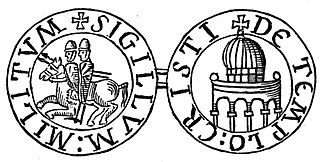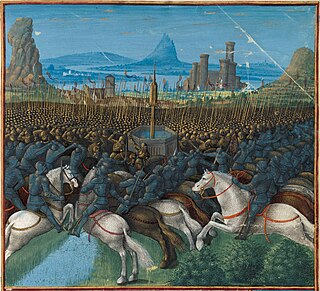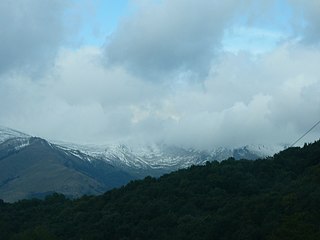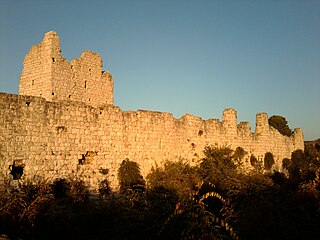Related Research Articles

The Poor Fellow-Soldiers of Christ and of the Temple of Solomon, also known as the Order of Solomon's Temple, the Knights Templar, or simply the Templars, was a Catholic military order, one of the most wealthy and popular of the Western Christian military orders. They were founded in 1119, headquartered on the Temple Mount in Jerusalem, and existed for nearly two centuries during the Middle Ages.
Omne datum optimum was a papal bull issued by Pope Innocent II on 29 March 1139 that endorsed the Order of the Poor Knights of Christ and of the Temple of Solomon, in which the Templar Rule was officially approved, and papal protection given.

The Battle of Hattin took place on 4 July 1187, between the Crusader states of the Levant and the forces of the Ayyubid sultan Saladin. It is also known as the Battle of the Horns of Hattin, due to the shape of the nearby extinct volcano of that name.

A military order is a Christian religious society of knights. The original military orders were the Knights Templar, the Knights Hospitaller, the Order of Saint James, the Order of Calatrava, and the Teutonic Knights. They arose in the Middle Ages in association with the Crusades, both in the Holy Land, the Baltic states, and the Iberian peninsula; their members being dedicated to the protection of pilgrims and the defence of the Crusader states. They are the predecessors of chivalric orders.

During the period of the Crusades, turcopoles were locally recruited mounted archers and light cavalry employed by the Byzantine Empire and the Crusader states. A leader of these auxiliaries was designated as Turcopolier, a title subsequently given to a senior officer in the Knights Templars and the Order of the Hospital of St John of Jerusalem, in charge of the coastal defences of Rhodes and Malta.

The Battle of Cresson was a small battle between Frankish and Ayyubid forces on 1 May 1187 at the "Spring of the Cresson." While the exact location of the spring is unknown, it is located in the environs of Nazareth. The conflict was a prelude to decisive defeat of the Kingdom of Jerusalem at the Battle of Hattin two months later.

The Military Order of Christ is the former order of Knights Templar as it was reconstituted in Portugal. Before 1910 it was known as the Royal Military Order of Our Lord Jesus Christ and the Order of the Knights of Our Lord Jesus Christ. It was founded in 1319, with the protection of King Denis of Portugal, after the Templars were abolished on 22 March 1312 by the papal bull, Vox in excelso, issued by Pope Clement V. King Denis refused to pursue and persecute the former knights as had occurred in most of the other sovereign states under the political influence of the Catholic Church.

Robert de Craon or Robert Burgundio was the second Grand Master of the Knights Templar from June 1136 until his death. He was instrumental in getting papal sanction for the Templar Order, making it independent from ecclesiastical and secular authorities. Robert negotiated the expansion of the Order into the Iberian peninsula with the acquisition of castles and territory. He died on 13 January 1147 and was succeeded by Everard des Barres.

The String Quartet No. 13 in A minor, D 804, Op. 29, was written by Franz Schubert between February and March 1824. It dates roughly to the same time as his monumental Death and the Maiden Quartet, emerging around three years after his previous attempt to write for the string quartet genre, the Quartettsatz, D 703, that he never finished.

The Poor Fellow-Soldiers of Christ and the Temple of Jerusalem, or Templars, was a military order founded in 1119.
The Battle of Niš saw crusaders led by John Hunyadi and Đurađ Branković capture the Ottoman stronghold of Niš in Serbia, and defeat three armies of the Ottoman Empire. The Battle of Niš was part of Hunyadi's expedition known as the long campaign. Hunyadi, at the head of the vanguard, crossed the Balkans through the Gate of Trajan, captured Niš, defeated three Turkish pashas, and after taking Sofia, united with the royal army and defeated Sultan Murad II at Snaim (Kustinitza). The impatience of the king and the severity of the winter then compelled him to return home.
Malcolm Charles Barber is a British scholar of medieval history, described as the world's leading living expert on the Knights Templar. He is considered to have written the two most comprehensive books on the subject, The Trial of the Templars (1978) and The New Knighthood: A History of the Order of the Temple (1994). He has been an editor for The Journal of Medieval History and written many articles on the Templars, the Cathars, various elements of the Crusades, and the reign of Philip IV of France.

The Knights Templar trace their beginnings to the Latin Kingdom of Jerusalem in c. 1120 when nine Christian knights, under the auspices of King Baldwin II and the Patriarch Warmund, were given the task of protecting pilgrims on the roads to Jerusalem, which they did for nine years until elevated to a military order at the Council of Troyes in 1129. They became an elite fighting force in the Crusades known for their propensity not to retreat or surrender.

The Battle of Zlatitsa was fought on 12 December 1443 between the Ottoman Empire and Serbian Hungarian troops in the Balkans. The battle was fought at Zlatitsa Pass near the town of Zlatitsa in the Balkan Mountains, Ottoman Empire. The impatience of the king of Poland and the severity of the winter then compelled Hunyadi to return home, but not before he had utterly broken the Sultan's power in Bosnia, Herzegovina, Serbia, Bulgaria, and Albania.
Paul G. Halpern is a retired American educator, naval historian and documentary editor. His primary focus has been the history of the Royal Navy in the period surrounding the First World War and in Naval warfare in the Mediterranean during World War I. In describing his career of achievement in publishing six volumes of edited naval documents, "The Annual Report of the Council of the Navy Records Society" noted in 2016 that "Paul Halpern has served the Society notably". "Those who have edited a similar number are a distinguished group: Sir Julian Corbett, Michael Oppenheim, Professor David Syrett, and J. R. Tanner, while only Sir John Knox Laughton and the Admiralty Librarian David Bonner-Smith have outstripped him."
Crusade Texts in Translation is a book series of English translations of texts about the Crusades published initially by Ashgate in Farnham, Surrey and Burlington, Vermont, and currently by Routledge. Publication began in May 1996. The editors of the series, all from the United Kingdom, are Malcolm Barber, University of Reading; Peter Edbury, Cardiff University; Bernard Hamilton, University of Nottingham; Norman Housley, University of Leicester; and Peter Jackson, University of Keele.

The Priory of Vrana was a monastery near the Croatian town Vrana established as priory of Templars by the Hungarian king Béla II at the beginning of the 12th century. At the beginning of the 14th century the Hungarian perceptories of the Order of Hospitallers took over control of the monastery and established it as their priory.
The Council of Troyes was convened by Bernard of Clairvaux on 13 January 1129 in the city of Troyes. The council, largely attended by French clerics, was assembled to hear a petition by Hugues de Payens, head of the Knights Templar. Pope Honorius II did not attend the council, sending the papal legate, Matthew, cardinal-bishop of Albano. The council addressed issues concerning the Templar Order and a dispute between the bishop of Paris and king of France.
Jean de Ronay was knight of the Order of Saint John of Jerusalem who was appointed Grand Commander of the Knights Hospitaller by the Grand Master Guillaume de Chateauneuf in 1243 or 1244. He served as interim Grand Master of the Knights Hospitaller from 1244 to 1250 during the captivity of de Chateauneuf. He died in battle during the Seventh Crusade.
References
- ↑ "Interview with... Helen Nicholson". All About History. 7 December 2017. Retrieved 2019-05-30– via pressreader.
- 1 2 "Dr Helen J Nicholson". Resources for Studying the Crusades at Queen Mary University of London. Retrieved 2019-05-30.
- 1 2 Nicholson, Helen J. (1989). Images of the military orders, 1128–1291: Spiritual, secular, romantic (PhD). University of Leicester.